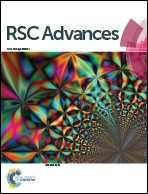Experimental and DFT studies for selective separation of Sb(iii) and Sb(v) from mixtures with Zr(iv)/Co(ii) using thiourea grafted polystyrene adsorbent
Abstract
A thiourea functionalized polystyrene adsorbent (TPS-DVB) is theoretically and experimentally investigated for selective sorption of antimony from acidic aqueous mixtures with CoCl2 and ZrOCl2. The optimal uptake of 35.6 and 24.2 mg g−1, respectively, was obtained for antimony(III) and antimony(V), at pH 1. The isotherm data could be well explained by the Langmuir model and the adsorption kinetics was successfully fitted in the pseudo first-order kinetics. Very high separation factors of 1129 and 918 were achieved for the Sb(III)/Co(II) and Sb(V)/Co(II) mixtures, respectively. The adsorption of Sb(III) and Sb(V) ions onto the TPS-DVB adsorbent was explored using the Density Functional Theory (DFT). These theoretical studies of metal coordination with the sulfur atom in the isothiourea group of the adsorbent showed stronger interaction of Sb(III) and Sb(V) ions over Co(II) and ZrO(II) ions. The inclusion of solvation model in the theoretical calculations improved the agreement between the experimental and the calculated metal–sulphur bond distances.


 Please wait while we load your content...
Please wait while we load your content...